Culture Watch
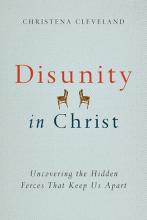
OVER THE PAST 2,000 years, Christians have found myriad ways to divide the body of Christ. We are now more divided than ever, with more than 40,000 Christian denominations worldwide. Perhaps, in this context, we are asking the wrong questions. Do we really understand God’s desire for the church to be one? Do we as individuals have a yearning for the unification of the body of Christ? Why do we create the divisions we create? Why do we maintain the divisions that already exist? How can we break through these barriers to heal a broken church?
Christena Cleveland sets out to answer all of these questions and more in her latest book, Disunity in Christ. Cleveland is a young, energetic, and brilliant teacher, speaker, and researcher in the fields of social psychology and faith and reconciliation. For those concerned with reconciliation in the church, which should be all of us, hers is a voice to take seriously.
In Disunity, Cleveland quickly breaks the ice by poking fun at herself and by pointing to her own personal prejudices and biases that have led to her categorically labeling fellow brothers and sisters in Christ as either a “right Christian” or “wrong Christian.” The reader is immediately able to connect with her and realize the ways in which we have created division in our own lives, whether because of race, gender, orientation, education, location, socio-economic status, theology, or political affiliation. It also becomes apparent why we prefer our homogenous groups.

THERE ARE apparently 2,000 film festivals around the world, so the format of red carpet arrivals, gala screenings, and Q&A sessions that appear all but scripted in advance have become well and truly entrenched. The best festivals recognize that their purpose is to cast a spell over filmgoers and filmmakers alike, inviting them into a spacious place where the heart of the dream that led to the film being made and the audience’s reason for watching it can beat in a community of people who thirst for art that gives life. Unsurprisingly, the biggest festivals find it hardest to pull this off—asking for contemplative mutuality at Cannes or Sundance is like looking for a Buddhist tea garden at Disney World.
Yet film festivals can be places where small is indeed beautiful. It’s only the movies that need to be big—or at least their capacity to alchemize with the viewer’s autobiographical narrative. The trappings of VIP lounges, paparazzi, and celebrity gossip are just that: They trap the aesthetic air, creating distance between people and art. Smaller festivals may be more capable of nurturing something that really feels like community.
So when at North Carolina’s Full Frame Documentary Film Festival this spring we watched Visitors, Godfrey Reggio’s follow-up to his epochal Qatsi trilogy, and the diverse faces of human beings segued into natural landscape and a Louisiana cemetery, the sense of empathic connection with an artist who spent the first 14 years of his life in New Orleans and the next 14 as a Christian Brothers monk was palpable. The impossible-to-categorize musician Nick Cave portrayed a sly version of himself in the pseudo-documentary 20,000 Days on Earth, intercutting concert footage with a role-played therapy session, visits with friends, and a neo-noir road trip, to moving effect. And the gay rights courtroom drama of The Case Against 8 played to an audience of citizens whose state had adopted a constitutional amendment to ban same-sex marriage; the showing led to near-euphoric anticipation of how a better history can reverse this tide.

IN WALT DISNEY’S Tomorrowland, you still have to push the faucet to get water to wash your hands. I know this because I stood waving my soapy hands at the men’s room spigot for about 15 seconds, expecting water to magically appear, as it so often does these days. Finally the guy next to me said, “You have to push it.”
Still recovering from this irony, I left the men’s room and noticed, along the wall outside, a deserted bank of AT&T pay phones. The future, it turns out, just isn’t what it used to be, but then, at Disneyland, neither is the past.
It was a perfect blue, warm, sunny day in mid-April, Wednesday of Holy Week in fact, when I joined the cosmopolitan herd trekking from the Pinocchio parking lot to the gates of Disneyland—the original one, in California. But unlike the other middle-aged people there, I went unencumbered by children, and I didn’t pay $92 to enter the kingdom of Mickey. My trip was a corporate junket related to my higher-ed day job. I was responsible for three college students, but they had their per diem and didn’t need me, so I was free to wander, observe, and refuse to stand in those mile-long lines for the famous rides.
My first stop was on the faux turn-of-the-last-century Main Street, at “Market House.” It looks like an old-time general store, with wide-plank hardwood floors and rough lumber pillars. But closer inspection reveals a Starbucks in disguise: the same pastries, sandwiches, and drinks as at any Starbucks the world over. But the ultimate Disney touch was the small army of young Latina baristas behind the counter in floor-length, puffy-sleeved dresses straight out of Little House on the Prairie.

“I AM A storyteller,” says Daniel Beaty, “and my purpose in the world is to inspire people to transform pain to power.”
He was first inspired to share his stories when his third-grade teacher showed a videotape of Martin Luther King Jr.’s “I Have a Dream” speech. Now as a writer, actor, singer, teacher, and motivational speaker, his storytelling is expressed in a dizzying array of different forms and outlets. The week in April that Sojourners’ editorial assistant Rebecca Kraybill interviewed him, Beaty was doing daily performances in Los Angeles of a one-person play he wrote on the life of performer and activist Paul Robeson, “The Tallest Tree in the Forest” (in which he plays 40 characters and sings 14 songs) and, during the day, taping for a Ford Foundation-funded documentary on work he does with children of incarcerated parents.
This was just a fortnight after Beaty finished a six-week speaking tour in support of his memoir, Transforming Pain to Power: Unlock Your Unlimited Potential (Penguin-Random House). He’s also the author of a children’s book released in December 2013 by Little, Brown and Company, Knock Knock: My Dad’s Dream for Me, with graphics by award-winning illustrator Bryan Collier, which is an adaptation of a poem Beaty wrote about his experience growing up with an incarcerated father. “Knock knock down the doors that I could not” is one especially poignant line the father in the book writes to the son; it carries a call to healing and liberation that is found in all of Beaty’s work.
Kraybill talked with Beaty about the effects of mass incarceration on families, the power of a “theater sanctuary,” and how the arts call us toward “the capacity to do better.”
OURS IS A CHRISTIAN FAMILY STORY. It is also a loving, loyal, confused church story. There’s nothing all that unusual about it, really. But precisely because similar stories are unfolding in countless families and churches today, I want to share it.
I want you to see how sexual orientation and deeply held beliefs are at odds in ways that injure those we love. This debate is not simply about beliefs and rights; it’s about people who are created in God’s image. Those people may be like you or entirely unlike you. They may be your roommate or neighbor, your best friend or a colleague. They may be your son or daughter.
My dad would later tell me the day I came out to him was the worst day of his life. His sister had passed away the year before; his father years earlier. But the day I said “Dad, I’m gay” was the worst day of his life. To his credit, though, he didn’t tell me that at the time. He hugged me and listened as I nervously stumbled over my words for an hour and a half. Then he told me he loved me.
My mom, too, responded with open arms, but the news was hard for her to hear. She could barely eat for several days afterward, and she spent much of the next year deeply dispirited. Still, I was grateful for my parents’ unfailing compassion and love.
What that love would ultimately look like, though, was unclear.
MUSIC IS OFTEN regarded and consumed as something that fills a space—the chords of an organ resounding off the walls of a sanctuary, the beats of a drum circle riding on the breeze through a park, the harmonies of an orchestra flowing from my headphones into my ears as I write. Music even transcends physical spaces to permeate the heart and the soul with emotion.
In Music as Prayer, pastor and musician Thomas H. Troeger invites the reader to cherish and engage in music as an act of prayer. Taking into account the metaphorical, scientific, and practical aspects of music-making, Troeger illustrates the power of music to not only fill a space but to also clear a way for meaning and creativity. Building upon Henry Ward Beecher’s metaphor of a boat stuck on the shore, Troeger describes how the “mighty ocean-tone” of a church organ brings the “tide” needed to lift up the members of the congregation and set them free from the shore.
In what Troeger calls a “dialogic process,” music lends rich metaphors to language and changes the effect of language upon the listener. The same song played in two distinct styles can convey two completely different sets of emotions.
From the ancient flute invented 35,000 years ago to today’s smartphone streaming songs on demand, music has occupied a central part of the human story. The mystery of music lies in the way that sound waves can blend into melodies that speak directly to the human yearning for wholeness. Creating space for both celebration and lament, music has the capacity to hold opposing emotions in the same breath. Music can provide release from suppressed inner tension and give voice to even the most unspeakable emotions.
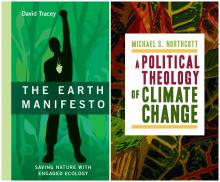
CLIMATE CHANGE and its accompanying issues are mammoth topics. David Tracey’s The Earth Manifesto and Michael S. Northcott’s A Political Theology of Climate Change are ambitious and sound theoretical and practical treatments.
With different faith backgrounds, each brings to the task the urgency of the moment. Tracey is a Vancouver urban ecologist, a fiction and nonfiction writer, a writing teacher, and an avid housing co-op dweller with his wife and two school-age children. He has spearheaded several community garden co-ops. Northcott is a priest in the Church of England and a University of Edinburgh social ethicist who has written on understanding space and its sacred sharing, urban ministry and theology, and now this, his third book on climate change.
Tracey’s The Earth Manifesto dives right into the ecological mandates of our time and place. It gently and consistently employs an implicit Buddhist perspective to offer concise chapters—really a set of tools—to name, address, engage, and sustain a meaningful citizens’ involvement. These are expressed in two parts: three big ideas and three big steps. The ideas consist of “Nature Is Here,” “Wilderness Is Within,” and “Cities Are Alive.” Tracey’s three big steps are “groundtruthing”—engaging deeply in a place to shape one’s environmental efforts; political advocacy; and building a community to help spread a campaign for change.
Two concepts stand out vividly. Tracey’s explanation of groundtruthing conveys the need to test a theoretical perspective by getting right on the ground to verify its potential in the concrete. One intuits incarnational theology here. He also affirms the nature of engagement from its French origins to mean “someone passionately committed to a cause”: pledged, dedicated, or devoted. For me this summons the discipline of spirituality in the service of social justice.

THE CLASSIC COMIC book hero is given a post-WikiLeaks spin in the film Captain America: The Winter Soldier. He realizes that he is being asked to participate in the extrajudicial killing of people whom a magic formula has decided might threaten the established order in the future. It’s intriguing that even Nick Fury, one of Captain America’s “bosses” at the superhero super-agency S.H.I.E.L.D. (lines of authority are never particularly clear when super powers are in play), almost goes along with this.
To build a new world, sometimes you have to tear the old one down, says character Alexander Pierce, played by Robert Redford in a role that both echoes and inverts the ones he often took in the ’70s—where, in films such as All the President’s Men and Three Days of the Condor, he fought the system from within for good. This time Redford’s having fun as a bad guy, while Captain America (aka Steve Rogers) is the golden boy flirting with the audience and inviting us into his subversive politics (indeed the first words he speaks—the first words of the movie—are “on your left”).
So The Winter Soldier is striving for far more than your typical comic book movie and has been clearly influenced by the Dark Knighttrilogy in aiming for philosophical depth. There are interesting ideas here—S.H.I.E.L.D. being part of the problem and the character Winter Soldier’s name evoking the 1972 documentary Winter Soldier about Vietnam vets expressing regret. There are fun bits of business with Steve Rogers’ difficulties in adjusting to the contemporary world (such as the dawning reality that Star Wars andStar Trek are different things). And there’s real character development, especially in Rogers’ interactions with the Black Widow.

AS THIS IS written, the big, fat Hollywood blockbuster Noah is opening amid condemnation from some Muslims and evangelical Christians and praise from most film critics.
Today, any product that touches the Bible is bound to be perceived as another entry in the culture wars. But that doesn’t seem to be what the producers and filmmakers had in mind with Noah. After all, it’s time-tested public domain material that presents great opportunities for computer-generated imagery (CGI) special effects. Paramount, the studio that put up the $125 million production cost, mostly wanted to peel off a slice of the Christian audience that flocked to Mel Gibson’s The Passion of the Christ and the History Channel’s Bible series.
But Noah was a culture war surrogate long before Russell Crowe donned his biblical robes. That’s because the creationist organization Answers in Genesis (AiG), which runs an anti-evolution Creation Museum in northern Kentucky, has for the past few years been trying to raise money to build a theme park anchored by a Bible-sized replica of Noah’s Ark. The Creation Museum is famous for such attractions as exhibits that depict humans and dinosaurs as neighbors. You may have heard it described as the museum for people who think The Flintstones was reality TV.
It’s a big job rebuilding Noah’s ark. The makers of the movie Noah only built to about a third of the biblical dimensions and used CGI for the rest. The price tag for the one planned in Kentucky is about $73 million. Early on, the project got a surprising boost from Kentucky’s governor, Democrat Steve Beshear. You may have seen Beshear on TV recently hyping Kentucky’s rollout of the Affordable Care Act. But before that, in 2010, Beshear came in for rounds of derision when he announced that our state would give $37 million in tax breaks to the ark attraction, as an economic development measure. When—or if—completed, the park is supposed to create 900 jobs and bring $250 million into Kentucky in its first five years.
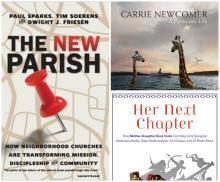
Reading Power
Her Next Chapter: How Mother-Daughter Book Clubs Can Help Girls Navigate Malicious Media, Risky Relationships, Girl Gossip, and So Much More advises on everything from basic setup to navigating challenging topics. By educational psychologist and girls’ empowerment advocate Lori Day, with her daughter, Charlotte Kugler. Chicago Review Press
Slices of Life
Fresh on the heels of an essay collection (The Thorny Grace of It: And Other Essays for Imperfect Catholics, Loyola Press), Portland Magazine editor Brian Doyle now offers prose poems that capture prayers, piercing insights, and luminous moments with craft and frequent wit in A Shimmer of Something: Lean Stories of Spiritual Substance. Liturgical Press
“THE CHURCH radicalized me,” celebrated author and ordained Episcopal deacon Denise Giardina once said, describing how she sees herself as both social activist and servant minister. “The phrase in the prayer book is ‘Interpret the world to the church and the church to the world.’ It’s a totally different way to advocate, with a spiritual point of view.”
This philosophy has shown up in her bestselling novels, published over her long career, such as Storming Heaven (1987) and The Unquiet Earth (1992), which chronicle the history and social impacts of coal mining in Giardina’s native Appalachia; Saints and Villains (1999), which tells the story of Dietrich Bonhoeffer’s resistance against Hitler and the Nazis; and, most recently, Emily’s Ghost (2010), a reimagining of Emily Brontë’s story and how her life was changed by her encounter with an ardent member of the clergy.
Shortly before her recent retirement from teaching creative writing at a West Virginia college, Giardina talked with Jason Howard, author of A Few Honest Words and coauthor of Something’s Rising, about her literary career, social justice activism, and her time in the late 1970s in Washington, D.C., as a member of Sojourners community (the intentional Christian community that founded Sojourners magazine and other ministries).

Bio: Tyrone Parker is the executive director of Alliance of Concerned Men (ACM), a nonprofit that works with youth living in high-crime areas in Washington, D.C.
1. What event or episode in your life has most informed your passion for working with urban youth and families?
One was the loss of my son, Rodney [who was killed in 1989]. The other was the record number of homicides within the District of Columbia. The District was once considered the “murder capital” of the United States.
When we first got started with the intervention program, it was due to a 12-year-old kid who was shot in the nation’s capital on the day of the Clinton inauguration. If you would’ve gone 10 minutes on East Capitol Street, you would’ve seen the inauguration with a major celebration. And 10 minutes down the same street, you had a whole community under house arrest. After that, we came together as a group to form the Alliance of Concerned Men.
2. What sorts of services and programs does ACM provide?
We teach a number of skills to at-risk youth, including gang intervention/prevention and mediation, workforce development, life skills training, leadership development, coaching for re-entry, and youth gang conflict resolution.
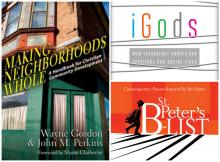
Everyday Saints
St. Peter’s B-List: Contemporary Poems Inspired by the Saints, edited by Mary Ann B. Miller, is not a collection of sentimental greeting-card-style verses; instead these literary works wrestle deeply with the human condition and the yearning for holiness, sometimes implicit, sometimes explicit. Ave Maria Press
City Missions
For nearly 30 years the Christian Community Development Association has been a resource for people seeking to do prophetic, non-paternalistic urban ministry. In Making Neighborhoods Whole: A Handbook for Christian Community Development, CCDA co-founders Wayne Gordon and John Perkins, and other veteran and emerging leaders, revisit key principles and lessons learned. IVP Books

IT IS FITTING that The Collected Poems of Denise Levertov (New Directions) begins with “Listening to Distant Guns,” written in 1940, when the poet was just 17: “The low pulsation in the east is war.”
The subject of war and its horrors, a constant in Levertov’s poetry and in her life, surfaces for the final time at the very end of this big book with these lines, written in 1997, from the poem “Thinking About Paul Celan”: You / at last could endure / no more. But we / live and live, / blithe in a world / where children kill children.
Denise Levertov (1923-1997), an American poet born in Ilford, England, to a Christian-Jewish father who was a descendant of Rabbi Schneur Zalman, founder of Chabad Hasidism, and a Welsh-Christian mother, herself the descendant of the Christian mystic Angell Jones of Mold, began to see her spiritual sensibility take a more formal religious shape only in her late 50s, when she opened to the liturgical, mystical, and social justice dimensions of Christianity, especially Catholicism, to which she later converted.
Two recent biographies, Dana Greene’s Denise Levertov: A Poet’s Lifeand Donna Krolik Hollenberg’s A Poet’s Revolution: The Life of Denise Levertov, explore deeply, albeit with inevitable overlap, the serial passions and enduring poetics of this singular artist.
At age 11, both biographers tell us, Levertov was going door to door peddling The Daily Worker in Ilford. At 12, she sent a batch of her poems to T.S. Eliot, and received back from him an encouraging response.
Poetry was her life’s purest passion. She had many lovers, many headlong, hurtful affairs to compensate for her romantically derailed and failed marriage to writer-activist Mitch Goodman. She also had a troubled relationship with their son, Nikolai, to whom Collected Poems is dedicated.
THE CULTURAL explanations and defenses for women undergoing genital mutilation, female infanticide, domestic violence, and other atrocities crumble under the weight of the cross. The involuntary suffering endured by millions of women is not redemptive; it is a suffering borne out of opposition to a God that desires to crush such bondage. An orientation of the cross emphasizes the importance of maintaining a precise language for a Christian perspective and application. According to Gerhard Forde, our modern culture has been so sensitized and psychologized that we are afraid to call a spade a spade. We often act many times “on the assumption that our language must constantly be trimmed so as not to give offense, to stroke the psyche rather than to place it under attack.” Our language can ultimately decline to a type of “greeting-card sentimentality.” Forde claims that when this happens we have lost our theological courage and legitimacy. A theology of the cross provides a paradigm or conceptual framework for a language that always speaks truth to power.
The language and meaning of the cross provide the most relevant and useful foundation for creating a practical social ethic for the work of ending violence against women and girls by identifying oppression, abuse, and violence as sin, and by providing a direction and necessary focus for the church. By using the language of the cross, the church embraces the gravity of violence against women and girls. It is not a “women’s issue” or merely another “social problem.” It is sin that violates the integrity and humanity of God’s creation. The work of Christ on the cross demands that the whole of the church respond to the ongoing evil and sin at work in the world. The power of God can be expressed through this language of the cross.
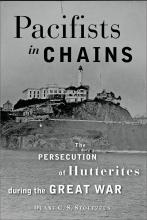
AS THE U.S. mobilized for World War I, a wave of patriotic fervor and xenophobia swept the country. Anything German was suspect, and those who were German-speaking and refused to fight against Germany were doubly suspect. Resentment and anger were directed at Anabaptist groups; several churches were burned and pastors beaten.
Inevitably, the demands of the state conflicted with the rights of conscience. Christian pacifists who only desired to be true to their beliefs by not serving in the military faced a militarized state that saw them as disloyal and disobedient. There was no legally recognized right to conscientious objection—if drafted, the only alternative for objectors was to go into the military and then refuse to participate.
Hutterite leaders had agreed that their young men would register, but if drafted and required to report for military service, their cooperation would end. They would refuse any orders making them complicit in war. Pacifists in Chains is the story of four young men—David, Michael, and Joseph Hofer, and Jacob Wipf—from the Hutterite colony in Alexandria, S.D., who faced that choice. Duane C.S. Stoltzfus, a professor at Goshen College in Indiana, was given access to previously unpublished letters from these men to their wives and families; the book is built around those letters.
Upon being drafted, the four reported in May 1918 and were sent to Fort Lewis, Wash. When they arrived, they immediately faced the test. Ordered to sign an “enlistment and assignment card” and line up as soldiers, they refused and were taken to the guardhouse. Following a brief court-martial, they were found guilty and sentenced to 20 years. Two weeks later, they were in chains and with armed guards on a train headed south to Alcatraz prison in the San Francisco Bay, then a military “disciplinary barracks.” Once there, they again refused to put on the uniform—in this case a military prison one—and were placed in solitary confinement in “the hole,” a basement dungeon. The cells seeped water and were infested with rats; the men were given bread and water to eat and subjected to beatings.

BEST-SELLING WRITER James Patterson recently established a million-dollar fund to support independent bookstores amid the current publishing industry crisis. Patterson is showing both generosity of spirit and humility before the audience that made him rich, not to mention an ethical commitment to the community-building impact and personal pleasures of smaller bookshops.
I think his open-minded and visionary idea should be translated to independent theaters too. The experience of entering shopping mall multiplexes to be seated in a shoebox and watch 25 minutes of advertisements before the same film that’s screening at every other multiplex does not resonate with the poetics of the art. And I mean that literally—beautiful cinema does not belong in an ugly industrial container. I mean “belong” literally too—if art is about belonging, about the idea of finding a home for our idea of ourselves, then it would make more sense to screen movies in environments that invite a sense of home, not evoke battery farms.
If James Patterson were to set up another million-dollar fund devoted to independent movie theaters, I’d be happy to help him spend it. I’d upgrade projection, audio, and lighting so that as much attention can be paid to how a film looks as to how paintings are hung in a gallery or music played in a concert. I’d make the seats comfortable for average-sized human beings. I’d give grants to community groups who want to refurbish their dilapidated downtown theater as a venue for the common good. I’d screen films that invite social change. I’d develop new distribution networks that challenge the dominance of the military-industrial-entertainment complex—offering the rights to screen films in exchange for an ethical fee or a gift in-kind. I’d have potlucks at 5:30 p.m. and movies at 6:30 p.m. so there’s enough time afterward to write poetry together or march on the capitol.

ON THE 2001 album Southern Rock Opera, over a thumping four-by-four beat and three roaring guitars, Drive-By Truckers front man Patterson Hood sang a song about “the duality of the Southern thing,” which he identified as equal parts “glory” and “shame.”
That pretty much sums up the paradox of a place like Hood’s native Alabama, where they celebrate the birthdays of Martin Luther King Jr. and Robert E. Lee on the same day. But up in the northwest corner of Alabama there stands a monument to the South’s unalloyed glory—the FAME recording studio in Muscle Shoals.
Beginning in the late 1950s, when segregation was still the law throughout the former Confederacy, at FAME black and white Southerners worked as partners, side by side, to make the sweet soul music that would help change the world. Percy Sledge’s “When a Man Loves a Woman,” Aretha Franklin’s “I Never Loved a Man the Way I Love You,” Wilson Pickett’s “Land of 1,000 Dances” and “Mustang Sally”—they were all recorded in Muscle Shoals within a two-year period in the mid-1960s.
And most of the musicians on all those deeply funky recordings were white Alabamans. The bass player, David Hood, was the father of the Truckers’ Patterson Hood.
That’s the story told in Greg “Freddy” Camalier’s film Muscle Shoals, premiering on the PBS series “Independent Lens” on April 21. The film features FAME founder Rick Hall, the FAME rhythm section of Roger Hawkins, Barry Beckett, Jimmy Johnson, and Hood (the boys Lynyrd Skynyrd dubbed “The Swampers”), and some of the artists who came to work with them—Aretha Franklin, Wilson Pickett, Percy Sledge, Mick Jagger, Keith Richards, and others. Musicians of more recent vintage testify to the abiding influence of the Muscle Shoals sound—such as Bono, Alicia Keys, and John Paul White, a local boy who found fame with The Civil Wars. And it’s all shot against the backdrop of the Muscle Shoals area’s wooded hills, lowland cotton fields, and, most of all, the magnificent Tennessee River upon which the life of the region still depends.

ANYTIME A PUBLIC figure dies, there are spontaneous vigils, piles of flowers and stuffed toys heaped at the star’s home or in a town square. But these outpourings of public grief aren’t reserved only for the rich and famous. In communities across the country, everyday people hold vigils when a child is abducted or a family murdered in a senselessly random act of violence. Sometimes a prayer is murmured. Often, it’s an opportunity for neighbors to mourn their shared loss.
Getting the message right in public grieving and memorializing hardly demands immense wealth or high-minded, thoughtful analysis. I’m heartened by impromptu candlelight vigils in the rain and messy memorials, because grief isn’t organized or tidy. On vacation in Hawaii last summer, boogie boards jammed in the sand as makeshift headstones seemed to line the Big Island’s Puna Coast, glittering stones and leis assembled at the base of each monument. “Sail away,” one paddleboard inscription read. Beside it, a laminated sheet of photos was tacked to a palm tree. On some of the more menacing lava rock cliffs, where it was clear more than a few had perished trying to catch a deadly wave, entire burial grounds with a dozen granite headstones were lined up, matching benches facing the row of markers.
While those cenotaphs, like the white crosses along desert highways and at urban intersections, could be troubling (so much sadness out in the open), we become more empathetic when we’re forced to slow down, reminded of our mortality and how loss—or even just the threat of impermanence—permeates most of our lives.
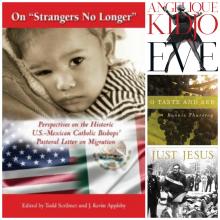
The Spirit’s Work
Just Jesus: My Struggle to Become Human, by Walter Wink with Steven Berry, is the final book by the late, influential Christian thinker. It blends brief autobiographical vignettes with essays on key themes in Wink’s work, offering insights into how his life story shaped his faith, thought, and witness. Image
Border Truths
On “Strangers No Longer”: Perspectives on the Historic U.S.-Mexican Catholic Bishops’ Pastoral Letter on Migration is a collection of essays by scholars and policy experts that uses the 2003 pastoral letter on immigration “Strangers No Longer: Together on the Journey of Hope” as its starting point. Paulist Press